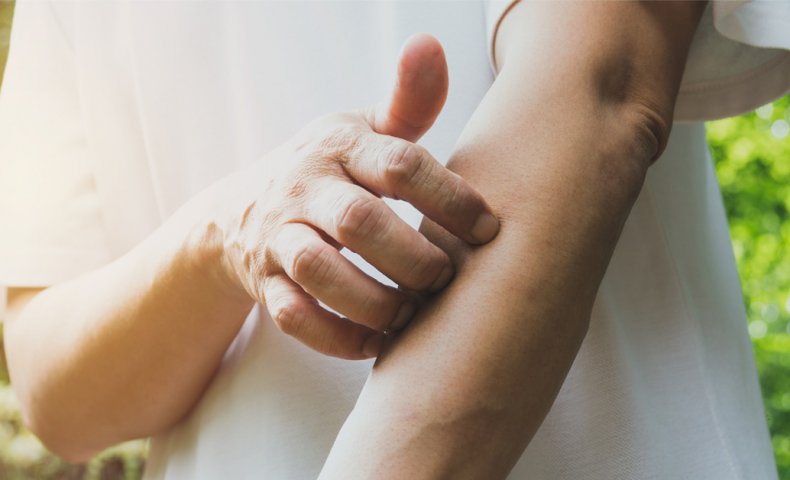
Summer is a great season for outdoor activities but it’s also the time of year when people are more prone to get things like poison ivy, sunburn, sun poisoning, chiggers and ticks. Prepare yourself for playing, reading and even picnicking in the backyard by learning about rashes and bites to watch out for.
Poison ivy, poison oak and poison sumac
This is a very itchy rash that you might get after making contact with a poison ivy, poison oak or poison sumac plant, which live in the woods. Usually, you will see red streaks that turn into itchy bumps on the surface of your skin, a rash known as contact dermatitis. Depending on which areas of your body are exposed, poison ivy, oak or sumac can be concentrated in one spot or spread out. You may not realize you were exposed to the plant for hours or even days afterward.
The best way to prevent this rash is to know what these plants look like and avoid making contact with them.
- Eastern poison ivy is a hairy, rope-like vine with three shiny green (or red in the fall) leaves. Western poison ivy is a low shrub with three leaves that doesn’t form a vine.
- Poison oak is a shrub with clusters of three leaves, similar to poison ivy, and may have yellow or green flowers and berries. It can also grow as a vine.
- Poison sumac is a shrub that contains stems with 7-13 leaves in pairs and may have glossy, pale yellow or cream-colored berries.
It’s also a good idea to be aware of people (or pets) who might have been in the woods, because you can sometimes get it by touching someone who has been exposed. If you do come into contact with one of these plants, try not to worry! Simply wash your skin and clothing to remove the plant oil.
If a rash begins developing, try an over-the-counter remedy. Some options are calamine lotion, oatmeal lotions,1% hydrocortisone cream and oral antihistamine like cetirizine (Zyrtec) or diphenhydramine (Benadryl). If you know you are allergic to ivy and you are going to be exposed, take an antihistamine ahead of time as it may help minimize a reaction. Dr. Mia Finkelston, who treats patients using LiveHealth Online, recommends having these at home just in case.
If the rash is worsening after trying remedies for 48 hours, or not responding after you’ve tried after 3-5 days, you may need to speak to a doctor. Also, even though poison ivy can be itchy and uncomfortable, try your best not to scratch.
Heat rash
Heat rash usually occurs in areas where the sweat glands are blocked and sweat is unable to come out of your skin. The rash can look like red patches, tiny blisters or bumps with pus inside. They may appear under a diaper, under heavy creams, in intense heat and under thick clothing worn in the heat. Heat rash is not always itchy and usually goes away on its own once the skin cools down.
Sun poisoning
If your skin has been exposed to the sun for too long, it will become red, swollen or possibly blistered. You may also have a headache, dry mouth, fatigue and in some rare cases you may not be able to think clearly. Sun poisoning can always be prevented. Try to limit your time in the sun, especially between 10am and 2pm, which is when the sun is most intense. Also, be sure to drink plenty of non-alcoholic fluids and wear sunscreen that is at least 30 SPF.
Insect bites
Mosquitos, black flies, greenhead flies and other kinds of insects can leave itchy red marks on your skin. These bites usually do not cause blisters and tend to heal within 2-3 days. A topical hydrocortisone cream or calamine lotion often does the trick.
Most natural insect repellants don’t last long so plan to reapply these frequently. DEET, which is an unnatural insect repellant, is safe for all ages if the concentration is between 10-30%. See the instructions for adjusting the amount for children.
If you find a tick on you, save it and schedule a visit with your doctor so they can help you identify next steps.
Spider bites
If a spider crawls up your leg, try not to panic — they don’t often bite. If you are bitten, you will likely get one large bump that is not itchy. Black widow and brown recluse spiders are the only two spider species in North America whose bites may cause symptoms more serious than minor pain and swelling. Wash the area with soap and water and apply a cold compress for any swelling. If the bite mark does not improve, be sure to see a doctor as soon as possible.
If you or your child has a rash or bite that you’re concerned about, you can have a visit with a doctor online 24/7 using LiveHealth Online.
Comments and opinions from Dr. Mia Finkelston are hers alone. This is content from an interview and is not considered medical treatment.
Recommended Posts




